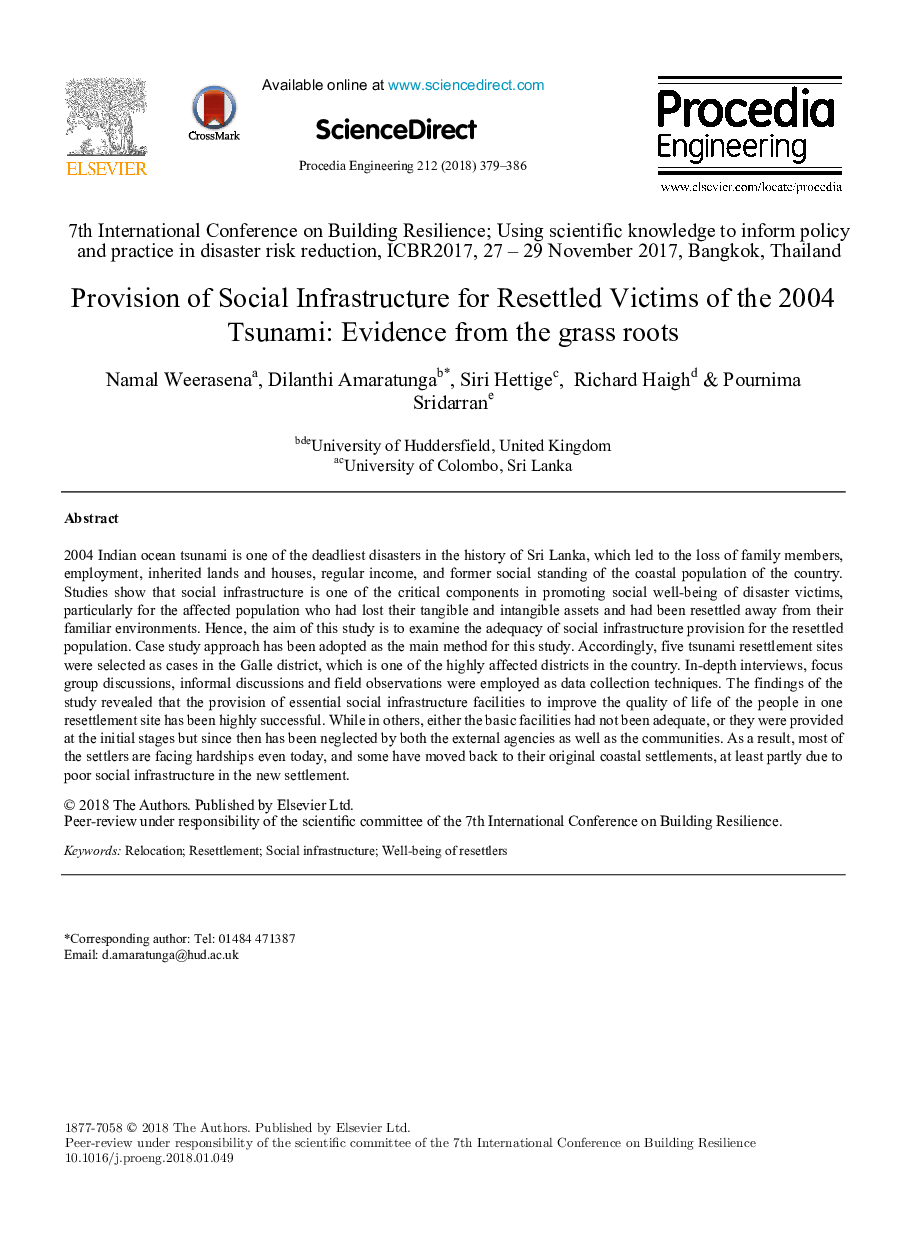| کد مقاله | کد نشریه | سال انتشار | مقاله انگلیسی | نسخه تمام متن |
|---|---|---|---|---|
| 7225991 | 1470611 | 2018 | 8 صفحه PDF | دانلود رایگان |
عنوان انگلیسی مقاله ISI
Provision of Social Infrastructure for Resettled Victims of the 2004 Tsunami: Evidence from the grass roots
ترجمه فارسی عنوان
ارائه زیرساخت های اجتماعی برای قربانیان محروم از سونامی 2004: شواهد از ریشه های عامیانه
دانلود مقاله + سفارش ترجمه
دانلود مقاله ISI انگلیسی
رایگان برای ایرانیان
کلمات کلیدی
نقل مکان اسکان مجدد زیرساخت اجتماعی، خوشبختی از بازنشستگان،
ترجمه چکیده
2004 سونامی اقیانوس هند یکی از مرگبارترین حوادث در تاریخ سریلانکا است که منجر به از دست دادن اعضای خانواده، استخدام، سرزمین ها و خانه های ارثی، درآمد منظم و موقعیت اجتماعی سابق ساکنین کشور شد. مطالعات نشان می دهد که زیرساخت های اجتماعی یکی از اجزای حیاتی در ترویج رفاه اجتماعی قربانیان بلاعوض است، به ویژه در مورد جمعیت آسیب دیده که دارایی های ملموس و غیرمالی خود را از دست داده اند و از محیط های آشناشان دور شده اند. از این رو، هدف این مطالعه، بررسی میزان کفایت تأمین زیرساخت های اجتماعی جمعیت های مجاور است. رویکرد مطالعه موردی به عنوان روش اصلی برای این مطالعه مورد استفاده قرار گرفته است. بر این اساس، پنج محل اسکان مجدد سونامی به عنوان موارد در ناحیه گال، یکی از مناطق بسیار آسیب دیده در کشور انتخاب شده است. مصاحبه های عمیق، بحث های گروهی تمرکز، بحث های غیر رسمی و مشاهدات میدانی به عنوان روش های جمع آوری داده ها صورت گرفت. یافته های این تحقیق نشان داد که تأمین امکانات ضروری زیرساخت های اجتماعی برای بهبود کیفیت زندگی مردم در یک محل اسکان مجدد بسیار موفق بوده است. در حالیکه در دیگران، امکانات اساسی کافی نبودند یا در مراحل اولیه ارائه شده بودند، اما از آن زمان هم از سوی سازمان های خارجی و هم جوامع نادیده گرفته شده است. در نتیجه بسیاری از مهاجران امروز حتی در معرض دشواری هستند و بعضی از آنها به ساکنین ساحلی اولیه خود دست می زنند، حداقل تا حدودی به دلیل زیرساخت های اجتماعی فقیر در حل و فصل جدید.
موضوعات مرتبط
مهندسی و علوم پایه
سایر رشته های مهندسی
مهندسی (عمومی)
چکیده انگلیسی
2004 Indian ocean tsunami is one of the deadliest disasters in the history of Sri Lanka, which led to the loss of family members, employment, inherited lands and houses, regular income, and former social standing of the coastal population of the country. Studies show that social infrastructure is one of the critical components in promoting social well-being of disaster victims, particularly for the affected population who had lost their tangible and intangible assets and had been resettled away from their familiar environments. Hence, the aim of this study is to examine the adequacy of social infrastructure provision for the resettled population. Case study approach has been adopted as the main method for this study. Accordingly, five tsunami resettlement sites were selected as cases in the Galle district, which is one of the highly affected districts in the country. In-depth interviews, focus group discussions, informal discussions and field observations were employed as data collection techniques. The findings of the study revealed that the provision of essential social infrastructure facilities to improve the quality of life of the people in one resettlement site has been highly successful. While in others, either the basic facilities had not been adequate, or they were provided at the initial stages but since then has been neglected by both the external agencies as well as the communities. As a result, most of the settlers are facing hardships even today, and some have moved back to their original coastal settlements, at least partly due to poor social infrastructure in the new settlement.
ناشر
Database: Elsevier - ScienceDirect (ساینس دایرکت)
Journal: Procedia Engineering - Volume 212, 2018, Pages 379-386
Journal: Procedia Engineering - Volume 212, 2018, Pages 379-386
نویسندگان
Namal Weerasena, Dilanthi Amaratunga, Siri Hettige, Richard Haigh, Pournima Sridarran,
